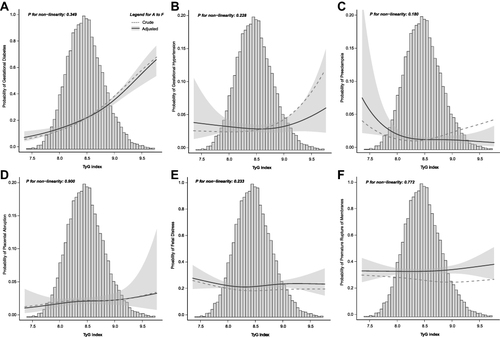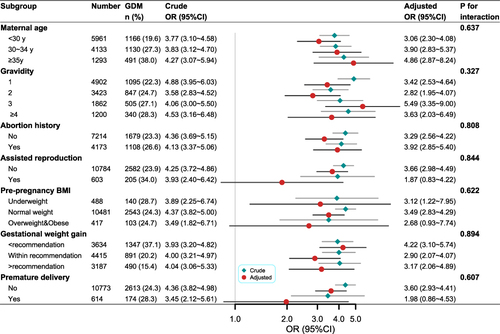Figures & data
Table 1 Anthropometric and Biochemical Characteristics of the Participants According to Triglyceride-Glucose (TyG) Index Quintiles
Figure 1 The risk of pregnancy-related complications with increasing triglyceride-glucose (TyG) index. The solid line represents adjusted probability and shadow parts 95% confidence intervals. Adjusted for race, pre-pregnancy BMI, maternal age, assisted reproduction, abortion history, gravidity, parity, gestational weight gain, delivery gestations, gestational week at the examination, systolic blood pressure, diastolic blood pressure, total cholesterol, low density lipoprotein cholesterol, high density lipoprotein cholesterol, hemoglobin, uric acid, creatinine, alanine aminotransferase, and aspartate aminotransferase. (A), Gestational diabetes mellitus; (B), Gestational hypertension; (C), Preeclampsia; (D), Placental abruption; (E), Fetal distress; (F), Premature rupture of membranes.

Table 2 Association of Triglyceride-Glucose (TyG) Index with Gestational Diabetes Mellitus (GDM)
Figure 2 Subgroup analysis of the association between triglyceride-glucose (TyG) index and risk of gestational diabetes mellitus (GDM). Models adjusted for race, pre-pregnancy BMI, maternal age, assisted reproduction, abortion history, gravidity, parity, gestational weight gain, delivery gestations, gestational week at the examination, systolic blood pressure, diastolic blood pressure, total cholesterol, low density lipoprotein cholesterol, high density lipoprotein cholesterol, hemoglobin, uric acid, creatinine, alanine aminotransferase, and aspartate aminotransferase (not for adjusted variables stratified analysis).

Table 3 Association of Triglyceride-Glucose (TyG) Index with Other Pregnancy-Related Complications
Table 4 ROC Analysis of the Triglyceride-Glucose (TyG) Index for Detecting Pregnancy-Related Complications
